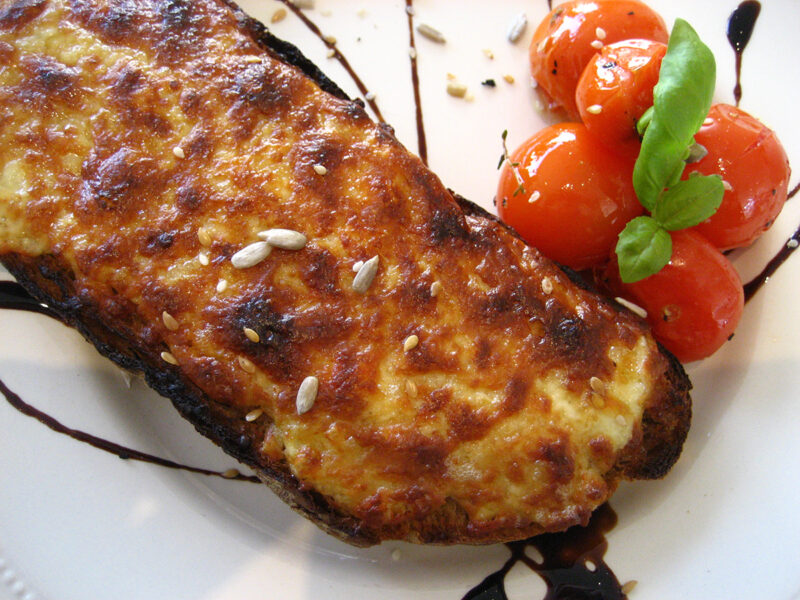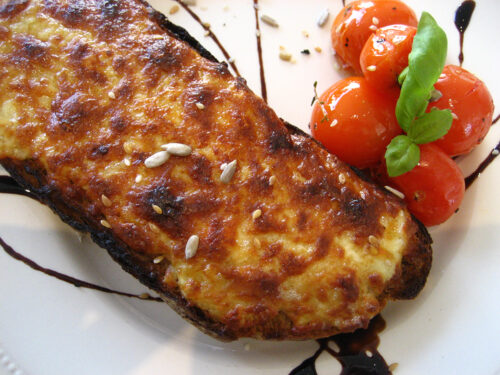A real “Taste of Wales” vegetarian recipe, this is a perfect snack or appetizer.

This is a magical dish with no actual rabbit in this Welsh Rarebit recipe! It represents a real ‘Taste of Wales” and is a perfect snack or better still, served up as a starter for a meal. It is also considered a posh version of cheese on toast, but as you will see, there is a bit more to it than just cheese on toast. It’s easy to do, and you can adapt the recipe to suit your own tastes. We hope you enjoy and whenever you come to stay with us, you can always ask for the house speciality! We also thought it might be appropriate to make you aware of the Welsh Rarebit legend.
The Welsh Rarebit Legend
In a society where most people could snare a rabbit for the cooking pot to celebrate our national day – St David’s Day, in Wales the poor man’s meat was considered as Cheese, while in England, rabbit was the poor man’s meat. The poorer Welsh often had to celebrate without the luxury of meat and would substitute the meal by cooking with melted cheese with beer and bread. It might also be understood that if a Welshman went rabbit hunting, this would be his supper and of course if he did not catch one, he had to turn to an alternative supper and this is how the name of the meal changes to Welsh Rarebit! There are many versions of this dish. Traditionally it is served on toast, sometimes with a poached egg on top. However many chefs have taken to using the rarebit mixture for more adventurous dishes such as a topping for fillet of Welsh beef, or for fillet of roasted cod. Of course it is ideal as a vegetarian dish and is exceptionally good poured over a dish of roasted vegetables, then baked in the oven until golden.
The following recipe is a basic rarebit mix, but the application is definitely a contemporary version of the toasted sandwich. You can add various flavorings to the rarebit base such as herbs, fresh chilli, garlic, cooked leeks, chopped ham, crispy bacon or chopped sun-dried tomatoes.
Welsh Rarebit Recipe
Ingredients for The Welsh Rarebit Serves 6
25g/1oz butter. If using leeks add extra butter for cooking the leeks.
375g/12oz Mature Welsh Farmhouse cheese. A good local mature or extra Cheddar Cheese will suffice.
100ml/4floz dark ale-like Guinness (another alternative is to use milk but it’s not as tasty)
1/2 teaspoon of mild grain mustard
2 Leeks finely chopped Salt and pepper to taste
Thick slices of Carved Ham or Crumpet or Bread Large Vine or Beef Tomatoes
Method
Start by frying the chopped leek in some of the butter in a pan and hold back to add after making the Rarebit. This will be used in dressing the top of the Rarebit just before serving.
To make the rarebit- Melt the butter in the pan, add the grated cheese and stir over a low heat until melted. Pour in the ale or milk, add the mustard and any other flavouring you wish. Season to taste with Salt and Pepper. Bring the mixture up to near boiling point, and then remove from the heat. Slice the Vine or Beef Tomato and pan fry with some fresh basil leaves that have been finely chopped. Toastie/Club Sandwich (Toasted) Simply toast slices of bread and spread the rarebit on toast and sizzle under the grill.
To create an impression with your guests, make it a Welsh Rarebit Club Sandwich. Simply toast the slices of bread and then take a large circular pastry cutter and cut circles. Place a tomato slice on top of the first base of toasted bread and top with the rarebit and top with another layer of toast. Then spread rarebit on this layer and sprinkle with chopped leeks for the top dressing. Place on a baking sheet and heat/brown either under a hot grill, or in a hot oven (preheated at the highest setting).
Serve immediately and enjoy. Lechyd da!
About the author: John Hadwin a top tour guide in North Wales and the owner of Boutique Tours of North Wales, specializing in private and small group tours. He is the owner of the Alice Court Guest House, an Edwardian Guest House right in the heart of the coastal town of Llandudno, which offers Tour and Stay sightseeing tours of North Wales, the Snowdonia National Park and the Isle of Anglesey.




